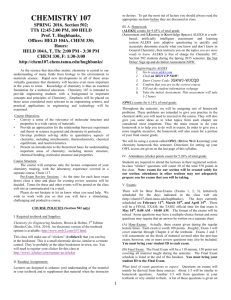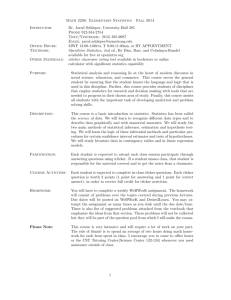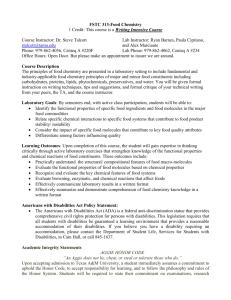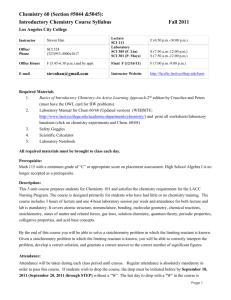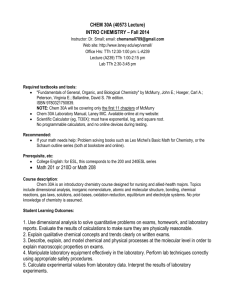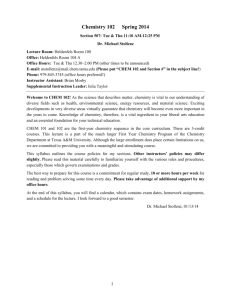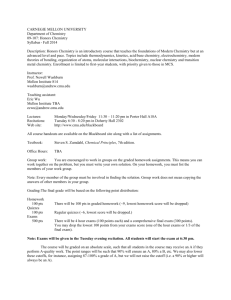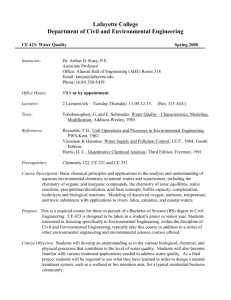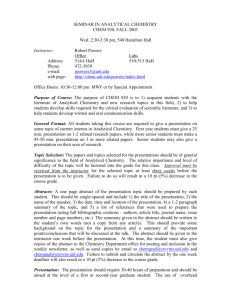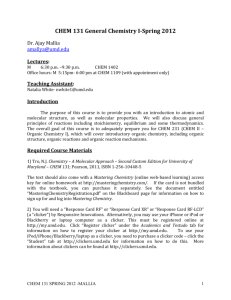CHEMISTRY 107 General Chemistry for Engineering
advertisement
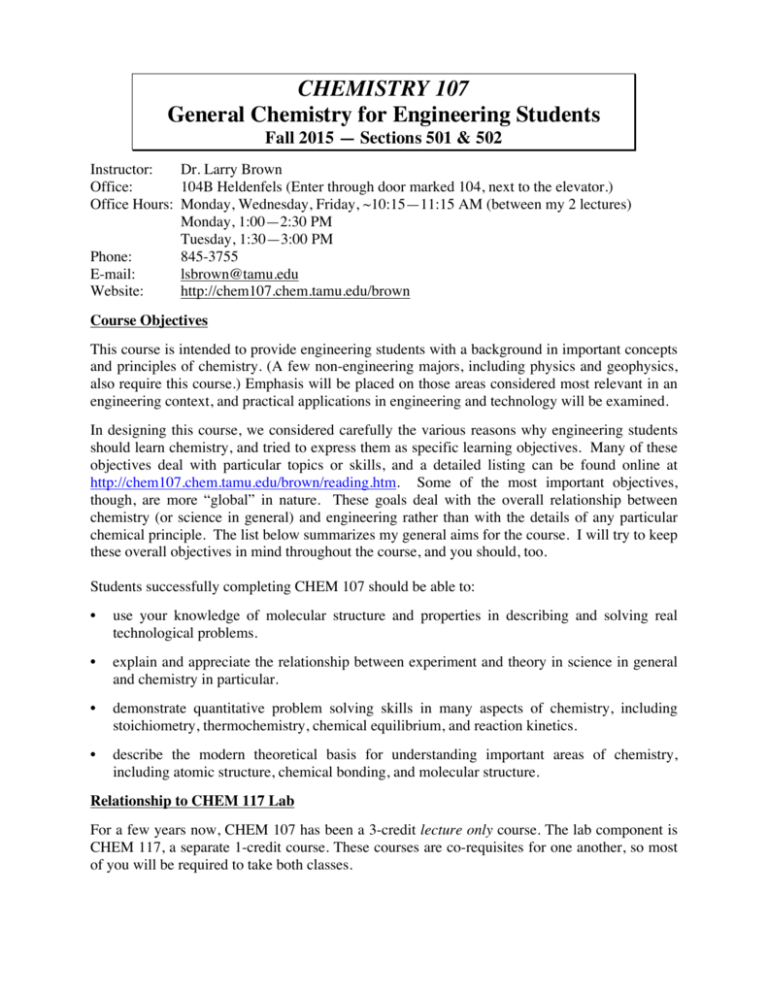
CHEMISTRY 107 General Chemistry for Engineering Students Fall 2015 — Sections 501 & 502 Instructor: Dr. Larry Brown Office: 104B Heldenfels (Enter through door marked 104, next to the elevator.) Office Hours: Monday, Wednesday, Friday, ~10:15—11:15 AM (between my 2 lectures) Monday, 1:00—2:30 PM Tuesday, 1:30—3:00 PM Phone: 845-3755 E-mail: lsbrown@tamu.edu Website: http://chem107.chem.tamu.edu/brown Course Objectives This course is intended to provide engineering students with a background in important concepts and principles of chemistry. (A few non-engineering majors, including physics and geophysics, also require this course.) Emphasis will be placed on those areas considered most relevant in an engineering context, and practical applications in engineering and technology will be examined. In designing this course, we considered carefully the various reasons why engineering students should learn chemistry, and tried to express them as specific learning objectives. Many of these objectives deal with particular topics or skills, and a detailed listing can be found online at http://chem107.chem.tamu.edu/brown/reading.htm. Some of the most important objectives, though, are more “global” in nature. These goals deal with the overall relationship between chemistry (or science in general) and engineering rather than with the details of any particular chemical principle. The list below summarizes my general aims for the course. I will try to keep these overall objectives in mind throughout the course, and you should, too. Students successfully completing CHEM 107 should be able to: • use your knowledge of molecular structure and properties in describing and solving real technological problems. • explain and appreciate the relationship between experiment and theory in science in general and chemistry in particular. • demonstrate quantitative problem solving skills in many aspects of chemistry, including stoichiometry, thermochemistry, chemical equilibrium, and reaction kinetics. • describe the modern theoretical basis for understanding important areas of chemistry, including atomic structure, chemical bonding, and molecular structure. Relationship to CHEM 117 Lab For a few years now, CHEM 107 has been a 3-credit lecture only course. The lab component is CHEM 117, a separate 1-credit course. These courses are co-requisites for one another, so most of you will be required to take both classes. Required Textbook & Supplies • Chemistry for Engineering Students, 3rd edition, Lawrence Brown and Thomas Holme (Brooks/Cole-Cengage Learning) The book is available in various formats: o Traditional hardcover textbook (ISBN 978-1-285-19902-3, available from bookstores in town, Amazon, etc.) o Looseleaf textbook, including e-book access and OWL access code (ISBN 978-1305-59965-9, available online at http://www.owlv2.com/TAMU (Priced at $75 on the Cengage site. May also be available in local bookstores.) The looseleaf/e-book option includes an OWL access code, which you will NOT need for my class. But that option is much less expensive than a new hardcover book, and probably less expensive than a used copy of the hardcover book. You should choose whichever format you believe would work best for you. You will have an option of using OWL to do additional practice problems, but those will not count for course credit. • iClicker classroom response device, usually called a “clicker.” You should be able to use either an iClicker2 device (ISBN #978-1-498-60163-4) or an app called REEF Polling. The clickers should be available at the various bookstores in town, or you can also find them online. The REEF Polling option is available as an app for iOS (an Android version should be released very soon), and there is a web version that can be used from any browser, meaning you could use your laptop, etc. For more information on REEF Polling, see https://www1.iclicker.com/products/reef-polling/. Whichever option you choose, you will need to bring it with you to class each day. Class Information and Announcements Announcements regarding schedule changes or other developments will be made in class at the earliest possible time. Information will also be available electronically via e-mail and the web. Website: http://chem107.chem.tamu.edu/brown The class website can be found at the above URL. This site offers a broad array of class information, including copies of the slide files used in class, old exams, and announcements. Electronic Mail I will often distribute class announcements by e-mail. The only simple way to do this is through the TAMUDirect system, which lets me send mail to the entire class roster. So any message I send out concerning class announcements will always go to your TAMU address. Please be sure to check that account regularly, or to set up a forwarding instruction if you prefer to read a different account. Grading Grades will be determined based on the following criteria. 3 Hour exams @ 100 pts. each 1 Final exam @ 150 pts. In-class “clicker” questions Homework total = 300 pts. = 150 pts. = 30 pts. = 60 pts. = 540 pts. Please note that things other than exams (i.e., homework and clicker questions) account for nearly 20% of your grade. Failure to do homework assignments or to attend class and respond to the clicker questions can drastically lower your course grade! Conversely, good scores on homework and clicker questions can also raise you course grade substantially. Letter grades will be assigned based on the percentage of the total course points earned, using the following scale. Note that your grade depends only on your scores, and not on class averages. ≥ 86 = A 62—73 = C 74—85 = B 50—61 = D < 50 = F Hour Exams Exams will be given on Fridays, September 25, October 23, and November 20 in our regularly scheduled lecture time. Each exam will focus primarily on material from the 4-week period since the previous exam. All exams may include questions or problems in any format: multiple choice, short answer, numerical problems, etc. Missed Exams There will be no regularly scheduled make-up exams. In the event that you miss an exam due to a university-approved absence, you should consult with me as soon as possible to discuss your situation. If possible, you should discuss your absence with me before the exam is given. Final Exam The Final Exam will be a two-hour, 150-point test covering all material taught during the semester. Final exams are scheduled at the following times. Section 501: Monday, December 14, 8:00 AM—10:00 AM Section 502: Wednesday, December 16, 10:30 AM—12:30 PM Homework Homework assignments will be given approximately weekly throughout the semester, and will be handled by the LON-CAPA electronic homework system. The homework points to be added to your grade will be determined by calculating the percentage of the assigned problems for which you have received credit. If you have done all the problems, you will receive 60 homework points. Doing half of the problems will get you 30 points, and so on. Please note that the homework counts for slightly more than 10% of your grade, so if you don’t do any of the problems, it will probably cost you a letter grade! More importantly, if you are not working problems regularly you are unlikely to be prepared to do well on exams. Clicker Questions Starting the week of September 7, each class will include one or more clicker questions. Most of these questions will be designed to start our discussion of a topic or check to see how well the class understands something we have been working on. Credit for such questions will be awarded to everyone who registers a response. Some clicker questions may act as mini-quizzes, for which credit will be awarded to all those registering a correct response. The number of points added to your final grade will be based on the fraction of the clicker questions for which you receive credit. In order to allow for a reasonable number of class absences, technical issues, etc., you will receive the full 30 points if you receive credit for at least 80% of the clicker questions over the course of the semester. Those who receive credit for less than 80% of the questions will earn points as determined by the following formula: # pts. awarded = # clicker questions for which you have credit × 30 pts (0.8) × total # of clicker questions Reading Assignments and Class Coverage A detailed calendar showing reading assignments associated with each day’s class is posted on the class website, and can be accessed directly at http://chem107.chem.tamu.edu/brown/reading.htm. Absences You are responsible for all material presented in class, even if you should happen to be absent. The slide files from the website and/or notes from a classmate can help you to be sure you know what you might have missed. If you miss an exam, you will be required to provide suitable documentation that your absence should be excused according to University rules and regulations (Student Rule 7). Whenever possible, you should discuss any upcoming absences with me in advance. Course Materials and Copyright Issues The handouts and other materials used in this course are copyrighted. Here “handouts” means all materials generated for this class, including but not limited to syllabi, quizzes, exams, lab material, class slide files, learning objectives, problem sets, and assorted materials appearing on the class website. Because these materials are copyrighted, you do not have the right to copy them for any purpose other than your own personal academic use unless I expressly grant permission. In particular, course materials are not to be given or sold to any profit-seeking enterprise. Academic Honesty “An Aggie does not lie, cheat, or steal or tolerate those who do.” Upon accepting admission to Texas A&M University, a student immediately assumes a commitment to uphold the Honor Code, to accept responsibility for learning, and to follow the philosophy and rules of the Honor System. Students will be required to state their commitment on examinations, research papers, and other academic work. Ignorance of the rules does not exclude any member of the TAMU community from the requirements or the processes of the Honor System. For additional information please visit: http://www.tamu.edu/aggiehonor. Students with Disabilities The Americans with Disabilities Act (ADA) is a federal anti-discrimination statute that provides comprehensive civil rights protection for persons with disabilities. Among other things, this legislation requires that all students with disabilities be guaranteed a learning environment that provides for reasonable accommodation of their disabilities. If you believe you have a disability requiring an accommodation, please contact Disability Services, Cain Hall, Room B-118 or call 845-1637. The Disability Services office is very busy every fall, so please make an appointment with them today if you feel you require assistance.
